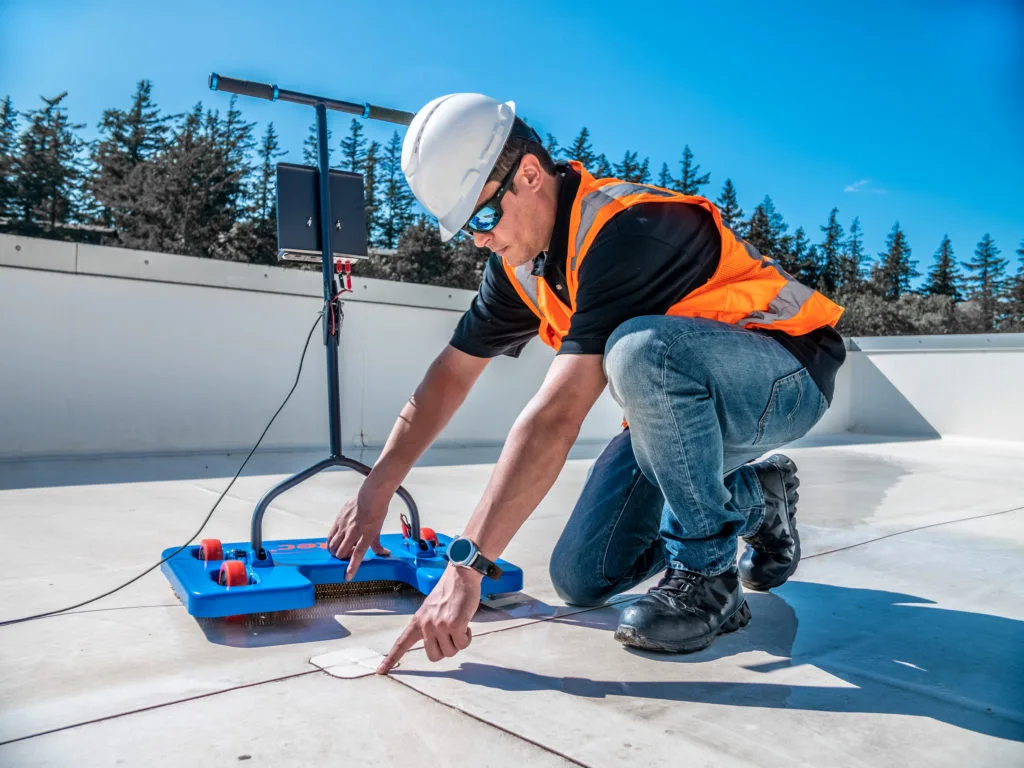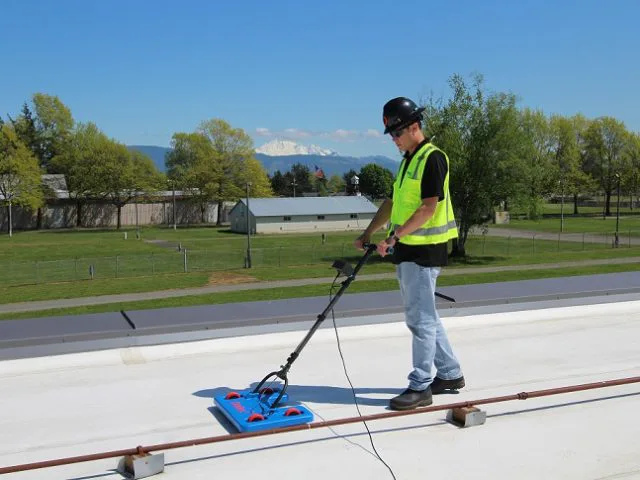Case Study: Roofing Integrity Saved by Electronic Leak Detection (ELD)
Roofing issues can cause extensive damage to a building if not addressed promptly and accurately. In this case, a commercial building owner faced recurring leaks despite previous repairs. Traditional methods had failed to identify the source of the problem, so our team used to pinpoint the exact locations of leaks and preserve the roof’s integrity.
The Property
- Type: Multi-story commercial building
- Location: Suburban New Zealand
- Roof Type: Flat roof with a PVC membrane
- Age of Roof: 8 years
- Problem: Recurring water ingress causing damage to the top floor and disrupting tenants’ operations.
The property owner had attempted multiple repairs over several years, but the leaks persisted, leading to increased repair costs and growing tenant dissatisfaction.
Challenges
- Flat Roof Complexity:
- Flat roofs are particularly prone to pooling water, which can exploit even minor imperfections in the waterproofing membrane.
- Previous Repairs Masking Problems:
- Layers of patchwork repairs had been applied over time, making it difficult to visually assess the roof’s condition.
- Tenant Disruption:
- Ongoing leaks disrupted business operations for top-floor tenants, increasing pressure for a fast and effective resolution.
- Weather Dependency:
- Frequent rain in the area complicated traditional inspection methods, making it difficult to work during wet conditions.
Our Approach: Using ELD for Precision and Efficiency
To address these challenges, we implemented a detailed plan centered on Electronic Leak Detection (ELD):
- Initial Inspection and Assessment
Before beginning the ELD process, our team conducted a thorough visual inspection of the roof to understand the layout, previous repairs, and potential trouble areas.
- Identified Risks: Noted areas where water pooling and seam stress were likely to cause problems.
- Documentation: Created a detailed roof map to guide the ELD testing process.
- Electronic Leak Detection (ELD)
Using ELD, we tested the entire roof membrane for breaches:
- Low-Voltage ELD Testing:
- Conducted on the PVC membrane to detect pinhole leaks, punctures, and seam failures.
- The electrically charged roof surface revealed precise breach locations, even those hidden beneath layers of previous repairs.
- Waterproof Integrity Testing:
- Verified the effectiveness of the membrane in areas prone to pooling water.
- Data Analysis and Reporting
Once testing was complete, we compiled a comprehensive report for the building owner:
- Marked exact locations of leaks on the roof map.
- Provided visual documentation, including photographs and thermal imaging overlays, for clarity.
- Recommended targeted repair solutions for each identified breach.

Detec Intregriscan, leak detection | Rommel
Findings
The ELD process revealed several critical issues:
- Multiple Undetected Leaks:
- Four pinhole-sized breaches in the membrane that were invisible to the naked eye.
- Compromised Seams:
- Two seams had separated over time, allowing water to seep through during heavy rains.
- Mechanical Damage:
- One significant puncture caused by maintenance equipment during a prior roof repair.
- Inadequate Drainage:
- Poor drainage design contributed to water pooling, which exacerbated the membrane’s vulnerabilities.
Solutions and Actions Taken
Based on our findings, we implemented a targeted remediation plan:
- Seam Repairs:
- Used specialized welding techniques to reseal and reinforce all compromised seams.
- Pinhole Leak Patching:
- Applied high-performance, UV-resistant patches over the detected breaches to restore waterproof integrity.
- Drainage Improvements:
- Installed additional drains and adjusted the roof slope slightly to improve water flow and prevent pooling.
- Preventative Measures:
- Recommended protective mats for future maintenance to avoid punctures from equipment.
- Post-Repair Testing:
- Conducted a second round of ELD to confirm all repairs were successful and the membrane was fully watertight.
Results
The project was completed within two weeks, with minimal disruption to tenants. The results were highly successful:
- Leak-Free Roof:
- The ELD process ensured that all leaks were identified and repaired effectively.
- Reduced Repair Costs:
- Pinpointing exact leak locations eliminated the need for costly trial-and-error methods.
- Improved Tenant Satisfaction:
- The resolution of recurring leaks restored confidence in the property’s management and improved tenant retention.
- Extended Roof Lifespan:
- Targeted repairs and drainage improvements extended the lifespan of the roof by several years.
- Peace of Mind:
- The property owner was reassured by the thoroughness of the process and the final ELD report confirming a watertight membrane.
Key Takeaways
- Precision Matters:
Traditional leak detection methods can miss small or hidden breaches, leading to persistent problems. ELD provides unparalleled accuracy in identifying leaks.
- Cost-Effectiveness:
Using ELD reduces unnecessary repair costs by targeting only the areas that need attention.
- Maintenance Prevents Future Issues:
Regular roof inspections and the use of advanced technologies like ELD can prevent small issues from escalating into major repairs.
Conclusion
Leaks in roofing systems can cause significant damage if left unresolved. By employing advanced techniques like Electronic Leak Detection, property owners can protect their investments and ensure long-term performance.
At Rommel, our expertise in ELD and waterproofing solutions allows us to deliver precise, cost-effective results. If you’re dealing with roof leaks or want to safeguard your property with professional leak detection, contact us today. Let us help you maintain the integrity and value of your building.

